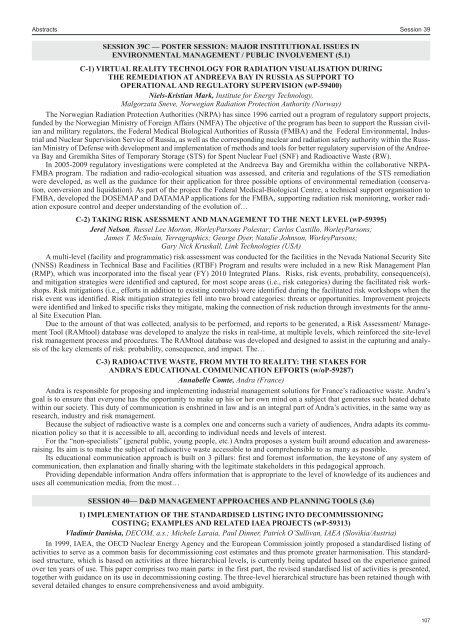ICEM11 Final Program 9.7.11pm_ICEM07 Final Program ... - Events
ICEM11 Final Program 9.7.11pm_ICEM07 Final Program ... - Events
ICEM11 Final Program 9.7.11pm_ICEM07 Final Program ... - Events
You also want an ePaper? Increase the reach of your titles
YUMPU automatically turns print PDFs into web optimized ePapers that Google loves.
Abstracts Session 39<br />
SESSION 39C — POSTER SESSION: MAJOR INSTITUTIONAL ISSUES IN<br />
ENVIRONMENTAL MANAGEMENT / PUBLIC INVOLVEMENT (5.1)<br />
C-1) VIRTUAL REALITY TECHNOLOGY FOR RADIATION VISUALISATION DURING<br />
THE REMEDIATION AT ANDREEVA BAY IN RUSSIA AS SUPPORT TO<br />
OPERATIONAL AND REGULATORY SUPERVISION (wP-59400)<br />
Niels-Kristian Mark, Institute for Energy Technology,<br />
Malgorzata Sneve, Norwegian Radiation Protection Authority (Norway)<br />
The Norwegian Radiation Protection Authorities (NRPA) has since 1996 carried out a program of regulatory support projects,<br />
funded by the Norwegian Ministry of Foreign Affairs (NMFA) The objective of the program has been to support the Russian civilian<br />
and military regulators, the Federal Medical Biological Authorities of Russia (FMBA) and the Federal Environmental, Industrial<br />
and Nuclear Supervision Service of Russia, as well as the corresponding nuclear and radiation safety authority within the Russian<br />
Ministry of Defense with development and implementation of methods and tools for better regulatory supervision of the Andreeva<br />
Bay and Gremikha Sites of Temporary Storage (STS) for Spent Nuclear Fuel (SNF) and Radioactive Waste (RW).<br />
In 2005-2009 regulatory investigations were completed at the Andreeva Bay and Gremikha within the collaborative NRPA-<br />
FMBA program. The radiation and radio-ecological situation was assessed, and criteria and regulations of the STS remediation<br />
were developed, as well as the guidance for their application for three possible options of environmental remediation (conservation,<br />
conversion and liquidation). As part of the project the Federal Medical-Biological Centre, a technical support organisation to<br />
FMBA, developed the DOSEMAP and DATAMAP applications for the FMBA, supporting radiation risk monitoring, worker radiation<br />
exposure control and deeper understanding of the evolution of…<br />
C-2) TAKING RISK ASESSMENT AND MANAGEMENT TO THE NEXT LEVEL (wP-59395)<br />
Jerel Nelson, Russel Lee Morton, WorleyParsons Polestar; Carlos Castillo, WorleyParsons;<br />
James T. McSwain, Terragraphics; George Dyer, Natalie Johnson, WorleyParsons;<br />
Gary Nick Kruskall, Link Technologies (USA)<br />
A multi-level (facility and programmatic) risk assessment was conducted for the facilities in the Nevada National Security Site<br />
(NNSS) Readiness in Technical Base and Facilities (RTBF) <strong>Program</strong> and results were included in a new Risk Management Plan<br />
(RMP), which was incorporated into the fiscal year (FY) 2010 Integrated Plans. Risks, risk events, probability, consequence(s),<br />
and mitigation strategies were identified and captured, for most scope areas (i.e., risk categories) during the facilitated risk workshops.<br />
Risk mitigations (i.e., efforts in addition to existing controls) were identified during the facilitated risk workshops when the<br />
risk event was identified. Risk mitigation strategies fell into two broad categories: threats or opportunities. Improvement projects<br />
were identified and linked to specific risks they mitigate, making the connection of risk reduction through investments for the annual<br />
Site Execution Plan.<br />
Due to the amount of that was collected, analysis to be performed, and reports to be generated, a Risk Assessment/ Management<br />
Tool (RAMtool) database was developed to analyze the risks in real-time, at multiple levels, which reinforced the site-level<br />
risk management process and procedures. The RAMtool database was developed and designed to assist in the capturing and analysis<br />
of the key elements of risk: probability, consequence, and impact. The…<br />
C-3) RADIOACTIVE WASTE, FROM MYTH TO REALITY: THE STAKES FOR<br />
ANDRA’S EDUCATIONAL COMMUNICATION EFFORTS (w/oP-59287)<br />
Annabelle Comte, Andra (France)<br />
Andra is responsible for proposing and implementing industrial management solutions for France’s radioactive waste. Andra’s<br />
goal is to ensure that everyone has the opportunity to make up his or her own mind on a subject that generates such heated debate<br />
within our society. This duty of communication is enshrined in law and is an integral part of Andra’s activities, in the same way as<br />
research, industry and risk management.<br />
Because the subject of radioactive waste is a complex one and concerns such a variety of audiences, Andra adapts its communication<br />
policy so that it is accessible to all, according to individual needs and levels of interest.<br />
For the “non-specialists” (general public, young people, etc.) Andra proposes a system built around education and awarenessraising.<br />
Its aim is to make the subject of radioactive waste accessible to and comprehensible to as many as possible.<br />
Its educational communication approach is built on 3 pillars: first and foremost information, the keystone of any system of<br />
communication, then explanation and finally sharing with the legitimate stakeholders in this pedagogical approach.<br />
Providing dependable information Andra offers information that is appropriate to the level of knowledge of its audiences and<br />
uses all communication media, from the most…<br />
SESSION 40— D&D MANAGEMENT APPROACHES AND PLANNING TOOLS (3.6)<br />
1) IMPLEMENTATION OF THE STANDARDISED LISTING INTO DECOMMISSIONING<br />
COSTING; EXAMPLES AND RELATED IAEA PROJECTS (wP-59313)<br />
Vladimír Daniska, DECOM, a.s.; Michele Laraia, Paul Dinner, Patrick O’Sullivan, IAEA (Slovikia/Austria)<br />
In 1999, IAEA, the OECD Nuclear Energy Agency and the European Commission jointly proposed a standardised listing of<br />
activities to serve as a common basis for decommissioning cost estimates and thus promote greater harmonisation. This standardised<br />
structure, which is based on activities at three hierarchical levels, is currently being updated based on the experience gained<br />
over ten years of use. This paper comprises two main parts: in the first part, the revised standardised list of activities is presented,<br />
together with guidance on its use in decommissioning costing. The three-level hierarchical structure has been retained though with<br />
several detailed changes to ensure comprehensiveness and avoid ambiguity.<br />
107
















